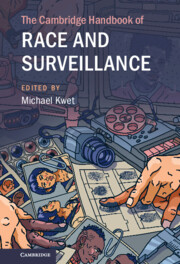Book contents
- The Cambridge Handbook of Race and Surveillance
- The Cambridge Handbook of Race and Surveillance
- Copyright page
- Contents
- Figures
- Contributors
- Acknowledgments
- 1 The Golden Age of Racial Surveillance
- 2 Sorting Identity
- 3 Imperial Mimesis
- 4 The Racialisation of British Women during the Long Nineteenth Century
- 5 Linking Caste and Surveillance
- 6 Surveillance in South Africa
- 7 Israel/Palestine, North America, and Surveillance
- 8 Colonialism’s Uneasy Legacy
- 9 China’s Surveillance and Repression in Xinjiang
- 10 Asian Americans as “the Perpetual Foreigner” under Scrutiny
- 11 The Great White Father and His Little Red Children
- 12 In a Most Excellent and Perfect Order
- 13 Surveillance and Public Schools
- 14 Surveillance and Preventing Violent Extremism
- 15 Resistance and the Politics of Surveillance and Control
- 16 Surveilled Subjects and Technologically Mediated Law Enforcement
13 - Surveillance and Public Schools
Policing, Desegregation, and the Criminalization of Minority Youth in Charlotte-Mecklenburg Schools
Published online by Cambridge University Press: 23 February 2023
- The Cambridge Handbook of Race and Surveillance
- The Cambridge Handbook of Race and Surveillance
- Copyright page
- Contents
- Figures
- Contributors
- Acknowledgments
- 1 The Golden Age of Racial Surveillance
- 2 Sorting Identity
- 3 Imperial Mimesis
- 4 The Racialisation of British Women during the Long Nineteenth Century
- 5 Linking Caste and Surveillance
- 6 Surveillance in South Africa
- 7 Israel/Palestine, North America, and Surveillance
- 8 Colonialism’s Uneasy Legacy
- 9 China’s Surveillance and Repression in Xinjiang
- 10 Asian Americans as “the Perpetual Foreigner” under Scrutiny
- 11 The Great White Father and His Little Red Children
- 12 In a Most Excellent and Perfect Order
- 13 Surveillance and Public Schools
- 14 Surveillance and Preventing Violent Extremism
- 15 Resistance and the Politics of Surveillance and Control
- 16 Surveilled Subjects and Technologically Mediated Law Enforcement
Summary
This chapter reveals how the concept of policing and surveillance of urban spaces has extended to K–12 schools. Comparing the initial intent of the use of police officers in schools to the ways in which police are deployed in the present day, empirical evidence shows that the espoused intent of improving the relationships between law enforcement and youth has quickly evolved into increased criminalization and incarceration of young, school-aged children for noncriminal activity, especially in K–12 schools where a majority of the student body is Black or Hispanic and White students are absent or in the minority. While policymakers have used random mass shootings, perpetrated almost exclusively by young, White males who attend suburban schools, as a major reason for increased hiring of police officers to patrol the schoolhouse, the ill-effects of the use of school resource officers (SROs) plague majority Black and Hispanic schools.
- Type
- Chapter
- Information
- The Cambridge Handbook of Race and Surveillance , pp. 255 - 266Publisher: Cambridge University PressPrint publication year: 2023

